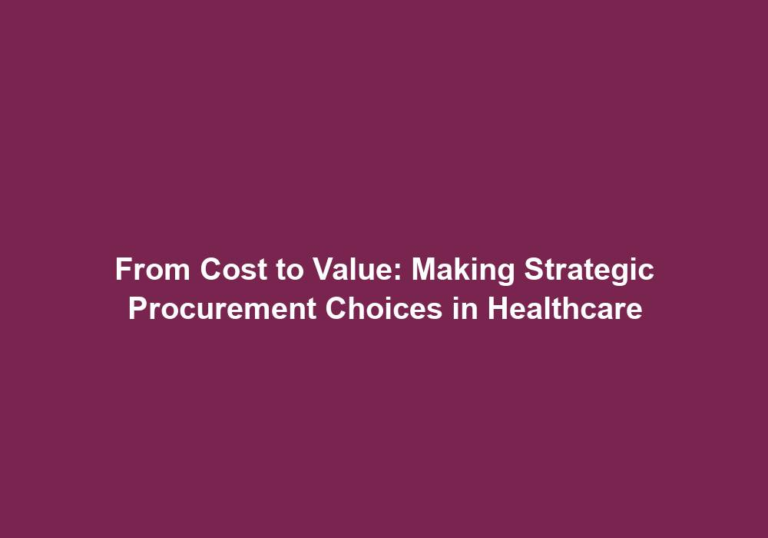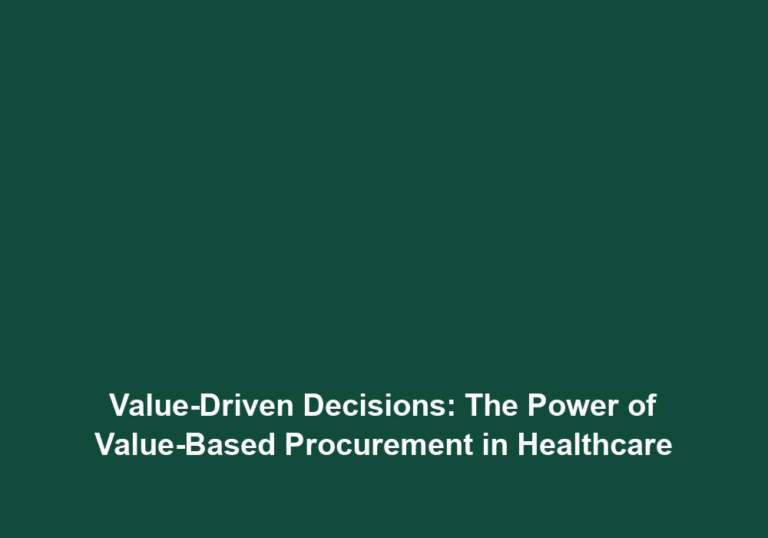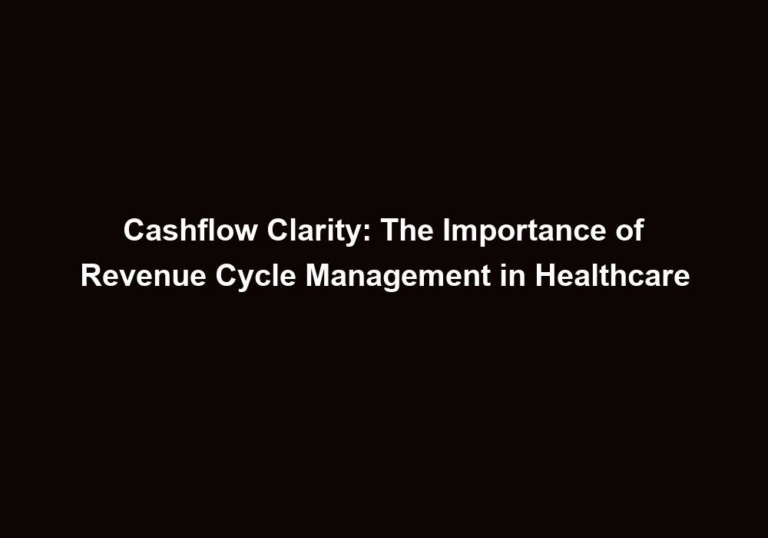Financial Fitness: Streamlining Expenses in Healthcare Management
In today’s fast-paced world, healthcare management is a critical aspect that demands utmost attention. As healthcare costs continue to rise, it is essential for organizations to adopt effective strategies to streamline expenses and improve financial fitness. This article delves into various methods and techniques that can help healthcare providers optimize their financial operations and navigate the challenging financial landscape.
Understanding the Healthcare Financial Landscape
Before we delve into the strategies for streamlining expenses, it is crucial to gain a comprehensive understanding of the healthcare financial landscape. Healthcare providers face numerous financial challenges, including:
- Rising Operational Costs: Healthcare organizations often struggle with increasing operational costs, including salaries, equipment, technology, and facility maintenance. These costs can quickly add up and impact the overall financial health of the organization. It is important for healthcare providers to carefully analyze their operational expenses and identify areas where cost-saving measures can be implemented.
-
Implementing Energy Efficiency Measures: By adopting energy-efficient practices, such as using LED lighting, optimizing HVAC systems, and implementing energy management systems, healthcare organizations can reduce their energy consumption and lower utility costs. This not only contributes to cost savings but also promotes environmental sustainability.
-
Exploring Outsourcing Opportunities: Healthcare organizations can consider outsourcing certain non-core functions, such as medical billing and coding, IT support, and janitorial services. Outsourcing can help reduce operational costs by leveraging specialized expertise and economies of scale.
-
Investing in Technology Infrastructure: Upgrading technology infrastructure can lead to long-term cost savings. By implementing electronic health records (EHR) systems, healthcare providers can streamline administrative processes, reduce paperwork, and improve overall efficiency.
- Reimbursement Models: The complexity of reimbursement models, such as fee-for-service, value-based care, and bundled payments, can pose significant financial challenges to healthcare providers. Understanding these models and optimizing revenue streams is crucial.
-
Staying Up-to-Date with Coding and Documentation Requirements: Accurate coding and documentation are essential for proper reimbursement. Healthcare organizations must ensure their coding staff is trained and regularly updated on the latest coding guidelines and documentation requirements. This helps prevent claim denials and optimize reimbursements.
-
Implementing Revenue Cycle Management (RCM) Solutions: RCM solutions automate and streamline the billing and claims process, reducing the chances of errors and delays. By utilizing RCM software, healthcare organizations can improve revenue cycle efficiency, accelerate reimbursement, and minimize revenue leakage.
-
Diversifying Revenue Streams: Healthcare organizations can explore opportunities to diversify their revenue streams. This can include offering additional services or expanding into new markets. By diversifying their revenue sources, healthcare providers can mitigate the financial risks associated with relying solely on one source of income.
- Regulatory Compliance: Compliance with ever-evolving healthcare regulations is not only imperative for patient care but also for financial stability. Non-compliance can result in hefty fines and penalties.
-
Investing in Compliance Training and Education: Healthcare organizations should invest in comprehensive compliance training programs to ensure that all staff members are aware of the latest regulations and guidelines. This helps minimize the risk of non-compliance and associated financial penalties.
-
Regular Audits and Internal Controls: Implementing regular audits and internal controls can help identify any areas of non-compliance and proactively address them. By conducting internal audits, healthcare organizations can identify potential compliance gaps and take corrective actions.
-
Collaborating with Compliance Experts: Healthcare organizations can partner with compliance experts or consultants who specialize in healthcare regulations. These experts can provide guidance and support in maintaining compliance and navigating the complex regulatory landscape.
Strategies for Streamlining Healthcare Expenses
To ensure financial fitness and sustainability, healthcare organizations must adopt proactive measures to streamline expenses. Here are some effective strategies to consider:
1. Implement Cost-Containment Measures
Cost containment focuses on reducing unnecessary or excessive spending without compromising patient care. Consider the following cost-containment measures:
-
Supply Chain Optimization: Analyze your supply chain processes and negotiate vendor contracts to achieve better pricing and reduce wasteful spending. Centralizing procurement may also lead to cost savings. By implementing inventory management systems and utilizing just-in-time inventory practices, healthcare organizations can minimize inventory holding costs and reduce the risk of expired or obsolete supplies.
-
Lean Management: Apply lean principles to identify and eliminate waste across various operational processes, such as patient flow, inventory management, and administrative tasks. By reducing waste, healthcare organizations can optimize resource utilization and reduce unnecessary expenses.
-
Utilization Review: Regularly review utilization rates for services, equipment, and supplies to identify areas of overutilization or underutilization. This allows for better resource allocation and cost savings. By implementing utilization management programs, healthcare organizations can ensure that resources are utilized efficiently and effectively.
2. Enhance Revenue Cycle Management
Effectively managing the revenue cycle is crucial for financial fitness in healthcare. Consider the following strategies to optimize revenue streams:
-
Streamline Claims Processing: Implement automated systems and technologies to streamline claims processing, reduce errors, and accelerate reimbursement. This includes leveraging electronic health records (EHR) and revenue cycle management software. By automating the claims submission process, healthcare organizations can reduce administrative costs, minimize errors, and expedite reimbursement.
-
Improve Coding Accuracy: Accurate and detailed coding plays a vital role in reimbursement. Train coding staff and implement regular audits to ensure compliance and optimize reimbursements. By investing in ongoing coding education and implementing coding accuracy checks, healthcare organizations can reduce the risk of claim denials and maximize revenue.
-
Negotiate Payer Contracts: Evaluate payer contracts regularly and negotiate favorable terms and rates to maximize reimbursement and minimize denials. By actively engaging in contract negotiations with payers, healthcare organizations can secure better reimbursement rates and improve their overall financial performance.
3. Embrace Technology and Data Analytics
Leveraging technology and data analytics can significantly enhance financial fitness in healthcare management. Consider the following approaches:
-
Health Information Systems: Implement robust health information systems that integrate various aspects of healthcare operations, including financial data, patient records, and inventory management. This provides a holistic view of the organization and enables data-driven decision-making. By utilizing advanced analytics tools and techniques, healthcare organizations can gain insights into their financial performance, identify trends, and make informed business decisions.
-
Data Analytics: Utilize data analytics tools and techniques to identify trends, patterns, and opportunities for cost savings. Analyzing patient demographics, utilization rates, and reimbursement data can uncover valuable insights. By leveraging data analytics, healthcare organizations can identify areas where costs can be reduced, improve resource allocation, and enhance overall financial performance.
-
Telehealth and Remote Monitoring: Embrace telehealth and remote monitoring technologies to reduce costs associated with in-person visits and hospital readmissions. This not only improves patient convenience but also optimizes resource utilization. By implementing telehealth solutions, healthcare organizations can reduce the need for physical infrastructure, lower operating costs, and improve access to care.
4. Foster Collaborative Partnerships
Collaboration and partnerships can help healthcare organizations streamline expenses and improve financial fitness. Consider the following strategies:
-
Group Purchasing Organizations (GPOs): Joining GPOs allows healthcare providers to leverage collective purchasing power, negotiate better prices, and access a wider range of products and services. By participating in GPOs, healthcare organizations can achieve cost savings through bulk purchasing and volume discounts.
-
Strategic Alliances: Collaborate with other healthcare organizations, such as hospitals, clinics, or specialty centers, to share resources, reduce duplicative services, and achieve economies of scale. By forming strategic alliances, healthcare organizations can pool their resources, reduce costs, and enhance overall operational efficiency.
-
Value-based Collaborations: Engage in value-based collaborations with payers and other healthcare entities to improve care coordination, optimize patient outcomes, and reduce unnecessary costs. By aligning incentives and implementing value-based care models, healthcare organizations can improve quality of care, reduce healthcare costs, and enhance financial performance.
Conclusion
In the ever-evolving landscape of healthcare management, financial fitness is a critical aspect for sustainability and success. By implementing cost-containment measures, enhancing revenue cycle management, embracing technology and data analytics, and fostering collaborative partnerships, healthcare organizations can streamline expenses and navigate the complex financial challenges they face. Achieving financial fitness not only ensures the long-term viability of healthcare providers but also enables them to deliver high-quality care to patients.







